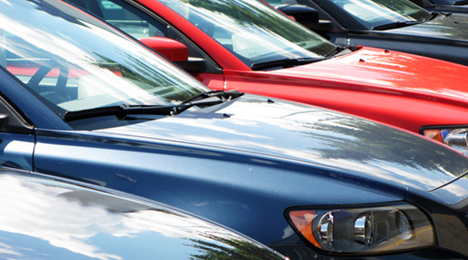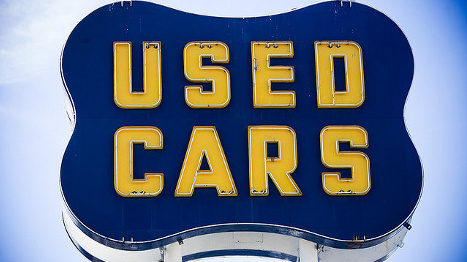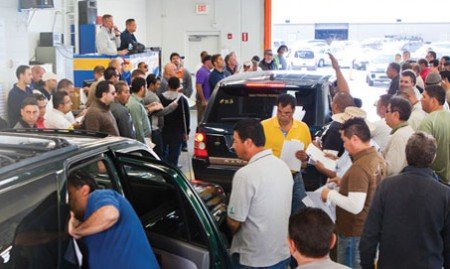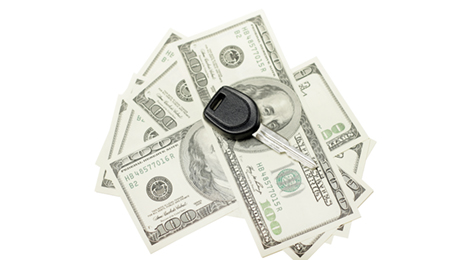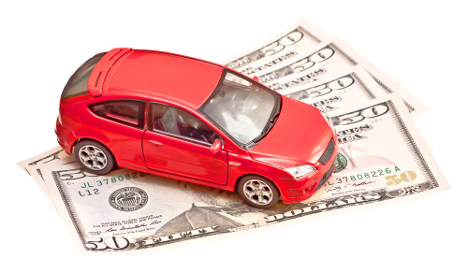Asbury Automotive Group announced across-the-board gross profit increases including a 7-percent increase on the used-car side.
The company retailed 18,840 used vehicles in the second quarter, which proved to be 1,137 more used vehicles sold than in the second quarter of 2013, a 6-percent increase.
Total used retail gross profit came in at $33.7 million, up from $31.5 million a year ago.
On a same-store basis, it was at $32.8 million, up from $31.5 million in the second quarter of 2013.
Same-store gross profit per used vehicle retailed was up 2 percent at $1,807. Used retail gross margins were at 8.6 percent, down from 9.0 percent a year ago.
Michael Kearney, Asbury’s executive vice president and chief operating officer, attributes the company’s overall success to the current automotive market situations and the Asbury employees’ dedication.
“The industry continued to gain momentum in the second quarter,” Kearney said. “Our teams continue to demonstrate the strength and diversity of the earnings power of the Asbury dealer model, delivering gross profit growth across all segments of the business.”
The company shared some other Q2 performance highlights compared to the same period the prior year:
- Total revenues increased 12 percent to $1.5 billion
- New-vehicle retail revenues up 12 percent
- Finance and insurance revenues up 11 percent
- Parts and service gross profit up 11 percent
- Total gross profit up 12 percent with increases from all business lines
- SG&A expense as a percent of gross profit improved 90 basis points to 68.3 percent
- Record operating margin of 4.8 percent
- Repurchased $20 million of Asbury common stock
- Closed on $60 million of mortgages in July
Asbury also acquired a Hyundai franchise in Deland, Fla. along with opening their first Q auto store in Brandon, Fla., the first in a future chain of stand-alone used vehicle stores the company has planned to open.
The company is on track to open a second Q auto store in the fall.
When it comes to the private retail industry — ranging from clothing and specialty foods to grocery stores and gas stations — used-car dealerships lead the pack for sales growth and profitability.
That’s according to financial information company Sageworks, who reported sales growth and profitability among used-car dealerships is higher than for all privately held retailers.
Take this for an example:
Used-car dealerships saw sales grow about 8 percent in both 2013 and the first half of this year, according to Sageworks data.
In comparison, privately held retailers across all product categories averaged 6.2 percent sales growth over the last 12 months.
And in 2011 and 2012, following the recession, used-car dealers saw an even bigger spike in sales.
According to Sageworks, used-car dealers grew sales by 10 percent and 11 percent in 2011 and 2012, respectively.
And sales isn’t the only metric growing for used-car dealers — they are making more on the pre-owned units, as well.
Used-car dealers’ profit margins averaged 4.1 percent in the most recent 12 months, Sageworks reported.
This number also marks a 6-year high and more than double industry’s 2009 net profit margin of 1.8 percent, according to Sageworks data.
For more on dealer profit margin movement, see the following Auto Remarketing story:
Sageworks: Revenue Growth Slows for Private Used-Car Dealers
AutoNation reported its best new-vehicle sales for the month of June since 2007.
The 25,450 units tallied last month marked a 1-percent increase over June 2013 and contributed to the retailer’s best second quarter new-car sales number (81,394) since 2006.
This quarterly mark was also a 10-percent increase over AutoNation’s second quarter last year.
AutoNation also broke down its overall new-car results by operating segment.
June 2014 Versus June 2013:
7,589 Domestics, down 7 percent
12,168 Imports, down 2 percent
5,693 Premium Luxuries, up 25 percent
Second Quarter 2014 Versus Second Quarter 2013
24,738 Domestics, up 3 percent
40,438 Imports, up 11 percent
16,218 Premium Luxuries, up 20 percent
Same-store sales saw a 7-percent increase for the second quarter of this year, up to 79,567 units sold. In June, same-store new-car sales (25,141) were even with year-ago figures (June 2013 had three more selling days).
Sales-wise, there wasn’t much growth to speak of in the used-car market during June. And there weren’t as many shoppers.
But the money — now, that was much better.
CNW Research said that based on the transaction prices it tracks, there was a 17.3-percent year-over-year increase in the total value of used-vehicles sold last month — and this amount was also up 5 percent from May.
With newer pre-owned inventory available for sale, transaction prices are rising, the firm said. And this has occurred in light of the fact that there were 7.6 percent fewer used-car shoppers at franchised dealerships in June, 29 percent fewer consumers going to independent stores and 5.6 percent fewer consumers shopping for private-party used-car deals, according to CNW.
“Average transaction prices are up a comfortable 16.7 percent over a year ago as fresher and newer vehicles begin to enter the used-car market,” company president Art Spinella said in his analysis accompanying the firm’s monthly used-car sales roundup.
Overall, used-car sales in June beat year-ago figures modestly, and both independent and franchised dealers were down more than 5 percent, but year-to-date numbers across the board are edging 2013’s first half.
CNW said there were 4.51 million used cars sold last month, up from 4.49 million in June 2013. Franchised dealers had 1.64 million used sales, compared to 1.74 million a year ago. Independents sold 1.45 million units, down from 1.53 million a year earlier.
There were 1.42 million casual sales in June, a 16.9-percent year-over-year increase.
In the first half of the year, used-car sales totaled 20.34 million vehicles, up from 20.14 million through the first six months of 2013.
Franchised dealers have pulled in 7.34 million used sales, compared to 7.30 million through June 2013. Independents are at 6.67 million, against 6.63 million in the year-ago period.
There were 6.34 million casual sales in the first six months of the year, up from 6.22 million in the same period of 2013.
When CarMax announced results from a successful first quarter of its 2015 fiscal year — notching record quarterly sales and earnings — company management focused on one used metric, in particular: wholesale unit sales.
While total used retail sales rose by 9.8 percent in Q1, wholesale unit sales were up slightly higher, experiencing a 9.9-percent spike.
The company sold 97,098 wholesale vehicles this past quarter.
The growth on the wholesale side of the business was due in part to increased appraisal traffic and a stronger wholesale vehicle buy rate, as well as the addition of new stores, the company said.
During the first quarter, the used-car giant opened four stores, including three stores in new markets (Rochester, N.Y.; Dothan, Ala.; and Spokane, Wash.) and one in an existing market (Harrisburg/Lancaster, Pa.).
Much of the company’s conference call to discuss Q1 financial results focused around their wholesale success, as investors questioned company management on what factors led to the rise in sales.
Tom Folliard, president and chief executive officer of Carmax, told listeners that management was a bit surprised both wholesale and retail sales rose in a similar fashion this past quarter, as the two metrics rarely follow the same trends.
“I’m glad I’m finally right in that I believe over time wholesale and retail will grow at a similar pace. In the past, they (wholesale and retail) seem to almost never be connected in a quarter … there is a lot of volatility in that business, but I still believe overtime that retail and wholesale will grow similarly over a long period of time.," Folliard said. "This quarter we happened to match up."
The company not only sold more wholesale vehicles, but they also made more profit on these units, as auction prices spiked high during tax season.
The average selling price for a CarMax wholesale vehicle in Q1 was $5,450, up 1.2 percent from the same period of the 2014 fiscal year.
“Well, in the spring, if this was what we would say a normal year, we would see some appreciation in the spring and then kind of a steady decline throughout the rest of the year,” said Folliard, commenting on the high wholesale prices this spring. “And this year, we saw more appreciation in the spring than we are used to. And lots of people attributed this to weather and pent-up demand for inventory. So we will go with that.”
And finally, dealers and buyers who struggled through a time of very tight used supply in the years following the 2008 economic downturn are finally seeing quality, used supply at auction expand.
Folliard said off-lease vehicles are beginning to feed the lanes in higher quantities, but he also pointed out another trend leading to growing wholesale supply at his company: trade-ins.
“It (supply expansion) is largely driven by consumer behavior, not just people who lease cars, but people who buy cars, and how quickly do they then trade those cars in," he explained.
And Folliard said the number of customers handing in the keys to their old rides is growing.
And this ties directly into an issue many conference call listeners asked about last week: the relationship between retail sales and wholesale unit sales.
Folliard suggested listeners take a look at the variables behind wholesale volume growth, such as “how many customers show up at the store? Of those customers, how many get their car appraised? Of the ones who get their car appraised, how many sell the car?
“There is always movement in some of those variables. We had a strong buyer rate, a little over 30 percent, slightly up compared to the year prior, and with total sales being up 10 percent and that being driven by foot traffic,” said Folliard. “It’s (wholesale to retail sales ratio) came out the way you think it would would come out.”
But Folliard stressed often over the course of the call: “But as I said, it’s just on a quarter by quarter basis, these two things are never exactly connected.”
Though incentive levels remained essentially flat in May, spending still came in at the second highest rate seen this year.
That’s according to Cars.com data, as the site reported on Wednesday that overall incentive spending in May came in at approximately $2,680 per vehicle.
NADA Used Car Guide also reported on incentive spending this week, noting that spending incentive spending remained essentially flat in May, growing by just 0.3 percent on an annual basis to an average of $2,673 per unit, according to Autodata Corp.
And as the seasonal summer slowdown approaches, incentive spending is expected to remain high throughout June and the rest of the summer, Cars.com predicts, as manufacturers rush to make room for new models.
"Manufacturers are still seeing relatively high inventory levels and are anxious to move metal," said Jesse Toprak, chief analyst for Cars.com. "Consumers will get the most value on any large-vehicle category this summer.
"The most significant inventory surplus is in the large-truck category, and as a result, we are seeing generous incentives from manufacturers and dealer discounting for vehicles such as the Silverado and F-Series. The popular mid-size sedan segment, which has become extremely competitive, is also full of models with relatively high incentives," he added.
Toprak said the industry is in the middle of a "perfect storm for attractive leases," created in part by high resale values and very low interest rates.
NADA UCG senior director of vehicle analysis and analytics Jonathan Banks offered additional analysis on last month’s spending in the latest NADA Guidelines report.
He pointed out that this past month’s minor increase, according to AutoData, was the smallest recorded in almost 18 months and "was also counter to historical trends as more often than not manufacturers push incentives higher in May."
Year-to-date, spending is at an average of $2,650, which is in line with April’s figure.
Though most manufactures are rushing to ramp up spending, Banks said, "Domestic brands continued to outspend their import counterparts on incentives by a wide margin in May."
For example, Buick’s incentive average of $6,024 per unit last month was highest among mainstream brands last month, and almost $4,000 higher than the industry average.
Chrysler came in second place for mainstream brands, with average incentive spending of $5,000.
And though GMC and Volkswagen spent similar amounts in incentives last month, at a combined average of $3,300, Banks pointed out the brand’s trends were headed in opposite directions.
VW’s figures represented a 34-percent increase, while GMC reduced spending by 24 percent last month.
"Incentives on Ford and Ram product was roughly $3,200 per unit, while spending for remaining brands was at or below the mainstream average of $2,700," Banks shared, rounding out the big non-luxury spenders in May.
Subaru, Mazda, Toyota and Hyundai have spent less per unit than other non-luxury brands year-to-date, with spending remaining low this past month.
Moving over to the luxury side of the business, luxury brand spending averaged $3,400 per unit in May, according to the NADA UCG report.
Cadillac led the pack with average spending of $6,156, up 16 percent year-over-year.
Lincoln’s average of nearly $5,500 followed closely behind, Banks said.
And though Infiniti dropped spending by 2 percent, its $4,500 spend per unit in May was still highest among import luxury brands.
Land Rover only spend $674 toward incentives in May, which marks the lowest incentive rate among luxury brands for the month. This was just below Porsche’s figure of $829.
Last month, the seasonally adjusted annualized rate for used-vehicle sales was the strongest it has been all year, according to Edmunds.com senior analyst Jessica Caldwell, who pinpointed May’s used SAAR at 36.3 million.
Calling it a “strong month for used sales,” Caldwell told Auto Remarketing that an ideal financing environment for franchised dealers was among the factors pushing the used market in May.
“The average finance rate for franchised used cars was quite favorable — the lowest we've seen in some time so that ultimately played a role in helping drive sales,” she said.
And even for dealers, franchised or independent, and lenders that work with consumers in lower-credit spectrums, the financing environment seemed to be a positive factor.
CNW Research found that turns to buyers with credit scores below 550 increased by more than 9 percent year-over-year as the industry posted 734,165 retail used sales to consumers typically considered to be either subprime or deep subprime.
Last month’s performance was even more positive for buy-here, pay-here dealers as CNW determined these operations saw their sales jump 20.9 percent in May versus the same month last year.
Staff Writer Nick Zulovich contributed to this report.
In a used-vehicle market that was static overall, franchised dealers increased their used sales more than 4 percent from a year ago, moving 1.42 million pre-owned units off their lots in May.
That’s according to the latest sales recap released today by CNW Research, which pegged May’s overall used sales total at 4.39 million units. This total — which includes numbers from franchised and independent dealers, as well as private-party transactions — was essentially unchanged from May 2013, CNW said.
Used sales were up almost 11 percent month-over-month.
As franchised dealers increased their used sales 4.3 percent year-over-year, independents sold 1.42 million used cars for a 3.4-percent gain.
There were 1.36 million casual sales, down from 1.48 million in May 2013.
Average used-car transaction prices for franchised dealers came in at $15,467, a 25.5-percent year-over-year increase driven by what CNW described as a newer and pricier inventory mix.
Meanwhile, transaction prices for independents fell from $7,218 to $6,883.
Prices in private-party deals climbed 8.3 percent to $7,519.
CNW said there was a 15-percent month-over-month and year-over-year increase in the total value of all monthly used sales, which it pinpointed at close to $45 billion.
Incentives were on the way up last month, as average transaction prices were reported to have fallen slightly from April.
According to TrueCar.com data, the average incentive spending for light vehicles in May was $2,677, up $17 (0.7 percent) from May 2013 and up $91 (3.5 percent) from April.
TrueCar estimated the ratio of incentive to average transaction price for light vehicles was 8.7 percent in May 2014, up 1.1 percent from May 2013 and up 7.5 percent from April 2014.
Perhaps a result of ramped up incentives, both TrueCar and Kelley Blue Book reported a slight decline in transaction prices from April.
KBB reported the estimated average transaction price for light vehicles in the United States was $32,307 in May, which is up $635 from May 2013 and down $79 from April.
“Small and midsize car share has declined slightly, as car shoppers opt for small and midsize crossovers, helping boost this month’s average transaction price,” said Karl Brauer, senior analyst for Kelley Blue Book. “Benefitting from strength among the crossover segment, the Acura MDX now comprises more than a third of Acura’s sales, boosting the brand’s transaction prices 5.5 percent year-over-year and helping keep Honda’s overall ATP flat.”
According to TrueCar data, the average transaction price was $30,646 in May 2014, down $149 from May 2013 and down $1,174 from April.
“Industry-wide, we saw average transaction prices contract slightly in May,” said Larry Dominique, president of ALG and executive vice president of TrueCar. “Conversely, Chrysler and GM were able to command higher prices, while shrinking their incentive spend-to-price ratio. This is a positive brand indicator for the two automakers.”
Highlighting transaction prices for individual brands, KBB analysts pointed out Volkswagen performed particularly well in May.
“Revealing a healthy average transaction price increase this month is Volkswagen Group, up 5.5 percent from last year,” said Alec Gutierrez, senior analyst for KBB. “However, this is due to a decrease in the share of Volkswagen brand sales and a corresponding increase in Audi share. Following the re-introduction of the entry-level A3 sedan, Audi’s average transaction price is down 2.5 percent year-over-year, while the Volkswagen brand is relatively flat.”
For domestic brands, Chrysler Group reported the biggest gain in average transaction price, reporting a 4.8 percent bump up from May 2013.
Based on the first half of the month, May’s used-vehicle sales volume will likely approach 4.5 million units and beat year-ago figures by 1.5 percent, according to CNW Research.
The firm said in its latest Retail Automotive Summary that it is forecasting 4.46 million used sales this month when accounting for the results of franchised and independent dealers as well private-party transactions. This would compare to 4.39 million in May 2013.
This would also put the year-to-date tally at just under 15.9 million, which outpaces the 15.65 million used cars sold through five months of 2013.
As for May alone, the biggest growth is expected to be among the independent dealers, whose sales are likely to increase 4.8 percent to 1.44 million. Meanwhile, franchised dealers are projected to boost their used sales 3.5 percent and move roughly 1.60 million units.
Casual sales will likely see a 3.7-percent dip with 1.42 million cars moved this month, CNW said.
The firm’s president, Art Spinella, explained some of the overall growth in dealer used sales: “The stable finance market, accepting wider and lower score consumers, has opened both franchised and independent dealers to a wealth of new shoppers who in the previous few years found it hard to get financing and relied on the casual market where they purchased older vehicles.”
Interestingly enough, though, dealers may want to pay attention to this next statistic: days’ supply of used cars has fallen. Spinella shed some light on why.
“This run on used vehicles has shrunk the days’ supply by 1.4 percent versus a year ago, and even though auction prices are not rebounding as one might expect, part of the reason remains a mismatched consumer demand versus inventory condition,” he said.

